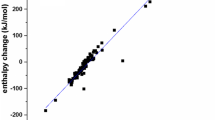Abstract
In this chapter, different adsorption mechanisms of cellulose hydrogel will be investigated. For this aim, computational simulation will be used. On an atomistic scale, cellulose hydrogel has different hydrogen bond properties. The OH groups can only act as hydrogen bond acceptors, but due to the negative charge density, there are still more water molecules assembled around adsorbents. Besides intermolecular hydrogen bonding, it has some hydrophobic properties. It means that some hydrophobic materials can be adsorbed on the surface of cellulose hydrogel at specific conditions. Most force fields for this simulation are empirical and consist of a summation of bonded forces associated with chemical bonds, bond angles, and bond dihedrals and nonbonded forces associated with van der Waals forces and electrostatic charge. Empirical potentials represent quantum mechanical effects in a limited way through ad hoc functional approximations.
Similar content being viewed by others
References
Marhöfer RJ, Reiling S, Brickmann J (1996) Computer simulations of crystal structures and elastic properties of cellulose. Ber Bunsenges Phys Chem 100(8):1350–1354
Matthews JF, Skopec CE, Mason PE, Zuccato P, Torget RW, Sugiyama J, Himmel ME, Brady JW (2006) Computer simulation studies of microcrystalline cellulose Iβ. Carbohydr Res 341(1):138–152
O’Sullivan AC (1997) Cellulose: the structure slowly unravels. Cellulose 4(3):173–207
Rizwan S, Dong Y-D, Boyd B, Rades T, Hook S (2007) Characterisation of bicontinuous cubic liquid crystalline systems of phytantriol and water using cryo field emission scanning electron microscopy (cryo FESEM). Micron 38(5):478–485
Wang Q, Johnson JK (1999) Computer simulations of hydrogen adsorption on graphite nanofibers. J Phys Chem B 103(2):277–281
Dislich H (1983) Glassy and crystalline systems from gels: chemical basis and technical application. J Non-Cryst Solids 57(3):371–388
Wang J, Somasundaran P (2005) Adsorption and conformation of carboxymethyl cellulose at solid–liquid interfaces using spectroscopic, AFM and allied techniques. J Colloid Interface Sci 291(1):75–83
Mohanambe L, Vasudevan S (2005) Structure of a cyclodextrin functionalized anionic clay: XRD analysis, spectroscopy, and computer simulations. Langmuir 21(23):10735–10742
Van der Klis J, Van Voorst A, Van Cruyningen C (1993) Effect of a soluble polysaccharide (carboxy methyl cellulose) on the physico-chemical conditions in the gastrointestinal tract of broilers. Br Poult Sci 34(5):971–983
Wellham E, Elber L, Yan D (1992) The role of carboxy methyl cellulose in the flotation of a nickel sulphide transition ore. Miner Eng 5(3):381–395
Biswal D, Singh R (2004) Characterisation of carboxymethyl cellulose and polyacrylamide graft copolymer. Carbohydr Polym 57(4):379–387
Paavilainen S, Róg T, Vattulainen I (2011) Analysis of twisting of cellulose nanofibrils in atomistic molecular dynamics simulations. J Phys Chem B 115(14):3747–3755
Dufresne A (2013) Nanocellulose: a new ageless bionanomaterial. Mater Today 16(6):220–227
Korhonen JT, Kettunen M, Ras RH, Ikkala O (2011) Hydrophobic nanocellulose aerogels as floating, sustainable, reusable, and recyclable oil absorbents. ACS Appl Mater Interfaces 3(6):1813–1816
Simon D, Kadiri Y, Picard G (2008) Nano cellulose crystallites: optical, photonic and electro-magnetic properties. In: NSTI NANOTECH 2008, technical proceedings, vol 1, pp 840–843
Shew C-Y, Yethiraj A (1999) Computer simulations and integral equation theory for the structure of salt-free rigid rod polyelectrolyte solutions: explicit incorporation of counterions. J Chem Phys 110(23):11599–11607
Oosawa F (1971) Polyelectrolytes. Marcel Dekker, New York
Christos GA, Carnie SL (1990) Computer simulations of polyelectrolyte chains in salt solution. J Chem Phys 92(12):7661–7677
Shiratori SS, Rubner MF (2000) pH-dependent thickness behavior of sequentially adsorbed layers of weak polyelectrolytes. Macromolecules 33(11):4213–4219
Wallin T, Linse P (1996) Monte Carlo simulations of polyelectrolytes at charged micelles. 1. Effects of chain flexibility. Langmuir 12(2):305–314
Bergenstråhle M, Wohlert J, Larsson PT, Mazeau K, Berglund LA (2008) Dynamics of cellulose-water interfaces: NMR spin-lattice relaxation times calculated from atomistic computer simulations. J Phys Chem B 112(9):2590–2595
Liu H, Sale KL, Holmes BM, Simmons BA, Singh S (2010) Understanding the interactions of cellulose with ionic liquids: a molecular dynamics study. J Phys Chem B 114(12):4293–4301
Kremer F, Huwe A, Schönhals A, Rózanski S (2012) Molecular dynamics in confining space. UK: Springer
Ermakov SV, Jacobson SC, Ramsey JM (2000) Computer simulations of electrokinetic injection techniques in microfluidic devices. Anal Chem 72(15):3512–3517
Zhigilei LV, Leveugle E, Garrison BJ, Yingling YG, Zeifman MI (2003) Computer simulations of laser ablation of molecular substrates. Chem Rev 103(2):321–348
Author information
Authors and Affiliations
Corresponding author
Editor information
Editors and Affiliations
Rights and permissions
Copyright information
© 2018 Springer International Publishing AG, part of Springer Nature
About this entry
Cite this entry
Jebali, A. (2018). The Adsorption Mechanism of Cellulose Hydrogel by Computational Simulation. In: Mondal, M. (eds) Cellulose-Based Superabsorbent Hydrogels. Polymers and Polymeric Composites: A Reference Series. Springer, Cham. https://doi.org/10.1007/978-3-319-76573-0_14-1
Download citation
DOI: https://doi.org/10.1007/978-3-319-76573-0_14-1
Received:
Accepted:
Published:
Publisher Name: Springer, Cham
Print ISBN: 978-3-319-76573-0
Online ISBN: 978-3-319-76573-0
eBook Packages: Springer Reference Chemistry and Mat. ScienceReference Module Physical and Materials ScienceReference Module Chemistry, Materials and Physics




